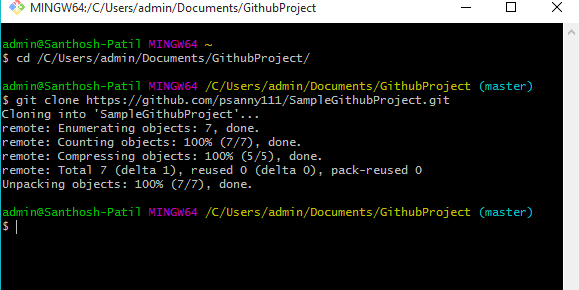
- Git add remote and init how to#
- Git add remote and init install#
- Git add remote and init update#
- Git add remote and init full#
- Git add remote and init download#
Git add remote and init how to#
Let's understand how to create a repository. We can create a repository for blank and existing projects. There can also be more than one project on a single repository. A repository is a directory that contains all the project-related data. Run the git remote set-url -add -push origin git-repository-name command where git-repository-name is the URL and name of the Git repository where you want to. For learning Git, it is essential to understand that how can we create a project on Git.
If you want to see it all together: git init git remote add originIf your remote repository is empty, this will automatically create a master branch. Git version control system allows you to share projects among developers. First, we add all of the files with add -A, then commit them with a message. It also initializes a HEAD pointer for the master branch of the repository. These metadata can be categorized into objects, refs, and temp files. This newly created subdirectory contains all of the necessary metadata. git subdirectory in the current working directory. Several Git commands run inside the repository, but init command can be run outside of the repository. It is used to make an existing project as a Git project.
Git add remote and init update#
Using the remote command, you will be able to update your existing Git submodules without having to run git pull commands in each. The git init command is used to create a new blank repository. In order to update an existing Git submodule, you need to execute the git submodule update with the remote and the merge option. To find out more about Git, read our article on getting started with Git for tutorials and books about Git.The git init command is the first command that you will run on Git.

In order to move an existing repository, type the following in your command line: cd my-git-repo You can do this easily by typing following in command line: git svn clone my-project In case you have used SVN repository before using Git, you would probably want to convert your repository to use it with Git. Import (clone) an existing SVN repository Git commit -m "Importing my project to Git, without saving history." To import your existing files from your local machine type the following in your command line: cd my-project The example above shows the latter, but you can find both URLs at the top right of each repo page. This command doesn't provide real-time access to repositories. These connections are more like bookmarks rather than direct links into other repositories. This command allows you to create, view, and delete connections to other repositories. Note: Beanstalk allows you to use SSH or HTTPS to connect to your Git repository. Git Remote command is used to connect your local repository to the remote server. Master branch is the default branch to use for your files. With the commands above, you will create a folder, add a file to it, make your first commit, and push the changes to your repository, to master branch. To start using your repository from scratch, in your command line type the following: git clone -o beanstalkĮcho "This is my new project on Beanstalk." > README We will show you a couple of common ways to start using your Git repository. Since Git is very flexible you can start using your repository easily by importing, cloning, and many other ways. it allows you to create and delete heads, tags and remotes and access the configuration of the. There are many different ways to use your Git repository. You can also initialize GitPython with a bare repository.
Git add remote and init install#
You need to do this only once, the first time you install Git.
 To add a new remote Git repository as a shortname you can reference easily, run git remote add
To add a new remote Git repository as a shortname you can reference easily, run git remote add Here’s how to add a new remote explicitly.
Git add remote and init full#
Git config -global user.email your full name and email address, and by this you will setup Git for your purposes. We’ve mentioned and given some demonstrations of how the git clone command implicitly adds the origin remote for you. git config -global user.name "John Smith"

Fire up your command line app such as Terminal (on Mac) or Git bash (on Windows) and run the following commands. Once installed, we recommend initializing Git. You can also install Git from source or use package management, for instance: yum install git-core
Git add remote and init download#
In case you don't have Git installed in Mac OS, you can download git-scm downloads or use a package manager like homebrew or MacPorts. We've put together a guide on installing Git to Windows. In order to use your git repository first you need to install Git. At the Remote Repository page of the Clone Repository wizard, specify the path to the repository required in the Repository URL field, for example, gitgithub. Getting Started with Git & Creating your Repository


 0 kommentar(er)
0 kommentar(er)
